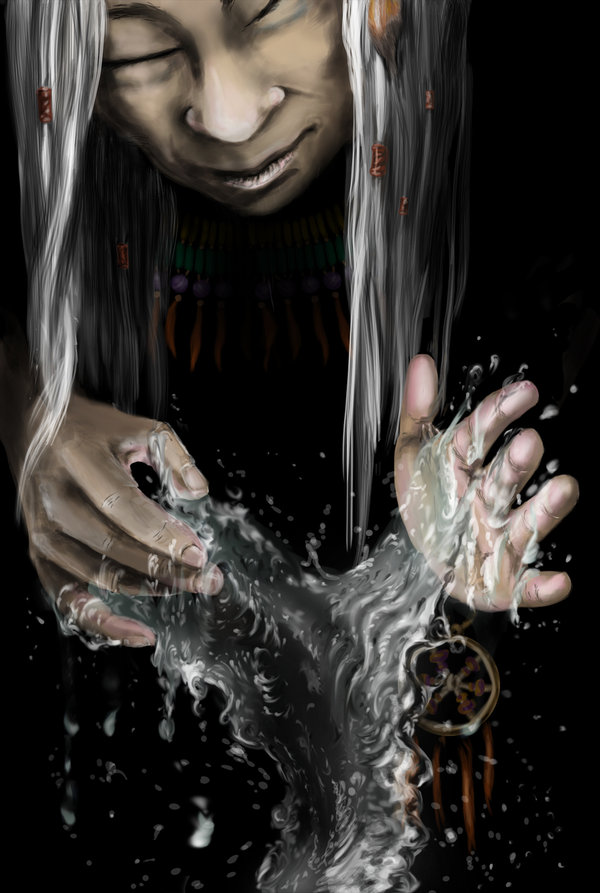Create Water
(Alteration)
Cleric only: retaW etaerC =
Water
[default: cleric, d: druid]

Create Water
(Alteration)
Cleric only: retaW etaerC =
Water
[default: cleric, d: druid]

|
|
|
|
|
|
|
|
|
|
|
|
|
(d: 1 cubic foot/level) |
|
|
|
|
Effect.Cleric:
When the cleric casts a create water spell,
four
gallons of water are generated for every level of experience of the caster,
i.e.
an Adept (C2) creates eight gallons of water,
a
Priest (C3) twelve gallons,
a
Curate (C4) sixteen gallons, etc.
The
water is clean and drinkable (it is just like rain water).
Created
water will last until normally used or evaporated, spilled, etc.
Water
can be created or destroyed in an area as small as will actually contain
the liquid or in an area as large as 27 cubic feet (one cubic yard).
Note
that water cannot be created within a living thing.
Destroy
Water: Reversing the spell, destroy water, obliterates
without
trace (such as vapor, mist, fog or steam) a like quantity of water.
MC: The spell requires at least a drop of water to create, or a pinch of dust to destroy, water.
Effect.Druid:
The druid can create pure, drinkable water by means of a create water spell.
He
or she creates 1 cubic foot of water for each level of experience attained.
The
water can be created to a maximum distance of 1” from the druid.
DMG.druid:
It is not possible to create water within living material,
i.e.
it is not possible to cast the spell upon a creature and create liquid
in any part of its body.
Question: Can a cleric
create water inside a non-living object?
If so, what would happen
if water is created inside a vampire?
Answer:
The question about creating water inside a vampire
apparent-
ly comes from the mention
in the MM that a vampire
can be killed by immersion
in running water. Unfortunately, the
AD&D
rules do not address the question of whether an undead
creature is considered “living”
for the purpose of casting Create
Water. The intent of the
rules, however, is made clear by the
description in the DMG (p.
43) of the druidic version of the spell:
“It is not possible to cast
the spell upon a creature” (presumably
including an undead creature)
“and create liquid in any part of
its body.” In any event,
creating water inside a vampire would
not have the desired (harmful
to the vampire) effect, since the
liquid is not running water,
as it would be if it came from a stream
or a spigot.
***
WSG: Obviously, a
life-saver when the party runs out of
water in the desert or any
other waterless environment. But remember
two important points: You
can’t take it with you unless
you have something to carry
it in, and you can’t make water unless
you have at least a drop
of water to begin with. (Whether saliva
or perspiration qualifies
as a material component in this case
is a matter for the Dungeon
Master to decide.)
<"Water
has an encumbrance value of 50 gp per gallon, plus an extra 50 gp for every
3 gallons in a single container." - WSG.53>
<1
waterskin = 8 pints = 1 gallon>
<see
page
2 of the 'Barrels' thread>
<Q1:
define gallon. US or UK?
A2:
US>
<Q2:
define wineskin.
A2:
1 waterskin = 1 gallon>
<
"Note
that water weighs 8 1/2 pounds per gallon and there are about 7 1/2 gallons
per cubic foot (total weight: 62.5 pounds per cubic foot)" - Polyhedron
42.19
Compare to the game numbers, a la the WSG: (5 pounds + 5 per 15 pounds)
and 7 gallons per cubic foot and 45 pounds per cubic foot.
Compare to the game numbers, a la the DMG: (5 pounds) and 7 gallons per
cubic foot and 35 pounds per cubic foot.
<
Cleric, Areas of Effect
| Level | Waterskins | Gallons | Cubic Feet | Encumbrance |
| 1 | 4 | |||
| 2 | 8 | |||
| 3 | 12 | |||
| 4 | 16 | |||
| 5 | 20 | |||
| 6 | 24 | |||
| 7 | 28 | |||
| 8 | 32 | |||
| 9 | 36 | |||
| 10 | 40 |
Druid, Areas of Effect
| Level | Waterskins | Gallons | Cubic Feet | Encumbrance |
| 1 | 1 | |||
| 2 | 2 | |||
| 3 | 3 | |||
| 4 | 4 | |||
| 5 | 5 | |||
| 6 | 6 | |||
| 7 | 7 | |||
| 8 | 8 | |||
| 9 | 9 | |||
| 10 | 10 |
<
1 cubic foot = 6 UK gallons = 600 gp = ? wineskins
1 cubic yard = 168 UK gallons = 16,800 gp = ?
(note that the 600 gp figure was rounded off)
>
<make similar tables for Create Food & Water>
<
<weights & measures>
<a pint has 16 oz. : cf. dmg.64>
<basically, 1 pint = 1 pound, to
start>
<1 gallon = 8 pints = 8 pounds
: wsg.53>
<here's where it gets strange>
<1 gallon = 0.5# per gallon, plus
an extra 0.5# for every 3 gallons being transported in a single container>
<a typical waterskin holds 1 gallon>
<1 cubic foot of water = 7 gallons>
>